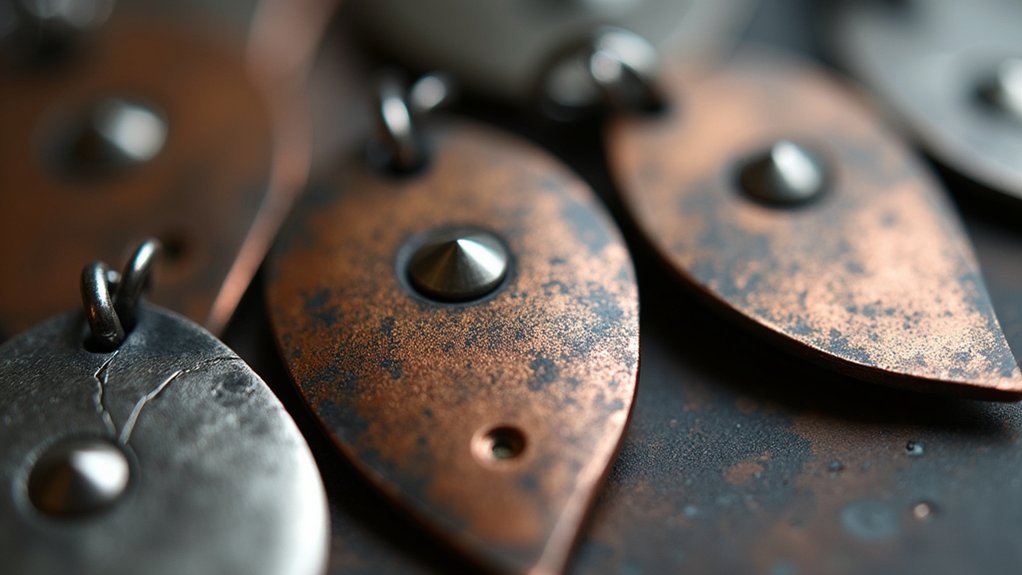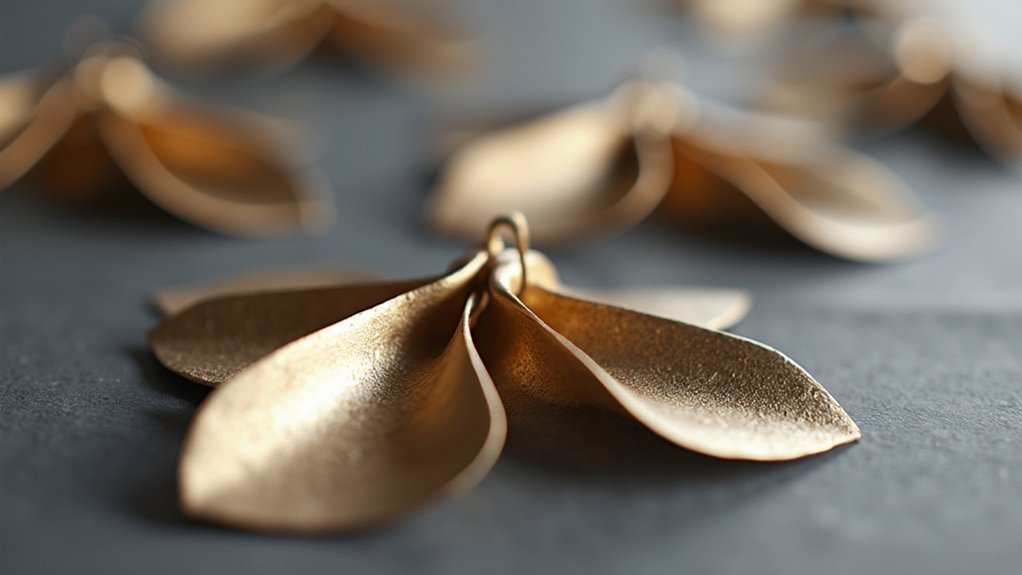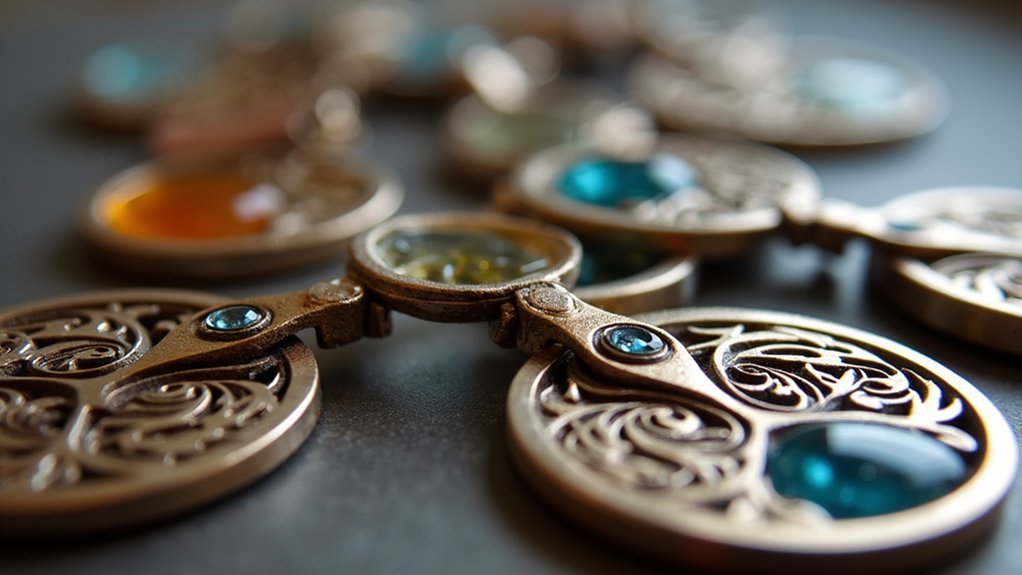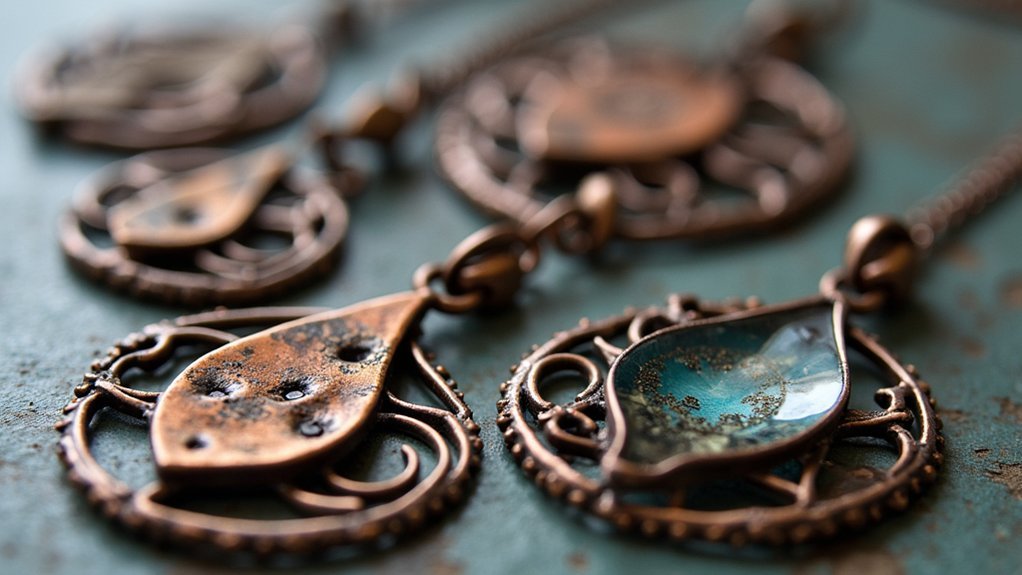Five easy cold connection techniques for metal pendants include riveting, which joins pieces through precise holes; wire wrapping, using 20-26 gauge wire to create decorative elements; tab construction, involving strategic folding of metal edges; micro-screw assembly, offering strength through tiny threaded fasteners; and epoxy adhesives, which bond diverse materials without heat. You’ll find these methods perfect for creating professional-looking jewelry without soldering equipment. Each technique opens up unique design possibilities for your metalwork projects.
Riveting: Creating Secure Metal-to-Metal Bonds

When you’re looking to join metal pieces without soldering, riveting offers a reliable and visually appealing solution. This classic cold connection technique creates strong metal-to-metal bonds that stand the test of time.
To create a secure connection, start by drilling holes through the layers of metal you want to join. Confirm the hole diameter matches your rivet size exactly—any gaps will compromise stability.
Select a rivet slightly longer than your combined material thickness to allow proper peening. Position your work on a steel bench block, insert the rivet, and use your riveting hammer to form the rivet head with firm, controlled strikes.
For larger drill holes, consider using open rivets with grommets, giving your pendant designs more versatility while maintaining structural integrity.
Wire Wrapping: Elegant Solutions for Pendant Elements
The artistry of wire wrapping transforms simple metal pendants into intricate works of wearable art without requiring heat or specialized equipment. Cold connections are created using wire gauges between 20 and 26, securing metal components while adding visual interest to your designs.
Wire wrapping: the elegant craft that transforms ordinary metal into extraordinary jewelry using only simple tools and creative vision.
You’ll find wrapped loops particularly useful for joining beads and pendants, preventing slippage while enhancing your piece’s aesthetic appeal. Create versatile connections using round nose pliers to form loops at both wire ends, allowing you to incorporate multiple elements seamlessly.
For added texture, try wire weaving—a technique where thinner gauge wire “stitches” components together, similar to sewing.
Jewelry makers should always finish their work professionally by trimming excess wire and smoothing sharp edges. This attention to detail elevates your jewelry design from amateur to sophisticated craftsmanship.
Tab Construction: Folding Metal for Seamless Connections

Metal tabs provide an elegant solution for joining pendant components without solder or heat. When you’re creating tab construction elements, start by cutting precise metal pieces that will be folded over at 90-degree angles to create secure connections between components.
To implement this technique in your jewelry making, measure carefully before cutting to guarantee your tabs fit perfectly with adjoining elements. File all edges smooth to prevent snagging or injury.
You can position tabs strategically around bezels to hold stones firmly in place or distribute them evenly across your design.
Remember that tabs aren’t just functional—they can be decorative additions that enhance your finished piece. Their clean lines and seamless appearance offer both structural integrity and visual appeal, making them essential elements in cold connection pendant designs.
Micro-Screw Assembly: Precision Joins With Decorative Potential
Precision engineering meets artistic expression in micro-screw assembly techniques for metal pendants.
These tiny threaded fasteners create strong, reliable connections while adding industrial aesthetic appeal to your jewelry designs.
To implement this technique, pre-drill holes in your metal pieces that match your micro-screw diameter. Choose screws with appropriate length for your pendant’s thickness to guarantee stability. Pair each screw with a matching nut to secure the connection.
What makes micro-screws particularly valuable is their dual functionality—they provide structural integrity while serving as decorative elements.
You’ll appreciate how easily you can disassemble and reassemble your pieces when adjustments are needed. This connection method works beautifully for modern pendant designs where you want to highlight rather than hide the mechanical aspects of your creation.
Adhesive Options: Epoxy Techniques for Mixed Materials

Versatile epoxy adhesives provide jewelry artists with robust bonding solutions when traditional metalworking techniques aren’t suitable for your pendant designs. Products like E-6000® Plus and Devcon Jewelers 2-Ton Epoxy create exceptionally strong bonds between metal pendants and various materials with minimal shrinkage during curing.
To maximize adhesive options for cold jewelry connections, prepare your surfaces properly—sand or drill small holes in your metal pendants to improve grip. Always clamp components together while the epoxy cures to guarantee seamless adhesion.
Surface preparation is the foundation of successful cold connections—create texture or drill anchor points before applying epoxy to ensure lasting bonds.
For more sculptural applications, try Apoxie Sculpt, which combines polymer clay flexibility with powerful bonding properties.
Before finalizing your design, test your selected epoxy techniques on sample materials to confirm compatibility. This preliminary step assures your mixed materials will maintain their strong bond through regular wear.
Frequently Asked Questions
What Are the Techniques for Cold Joining Metal?
You can join metals without heat using riveting (drilling holes for pins), adhesives (like epoxies), pierced connections (creating holes for wires), wireworking (wrapping and stitching techniques), and embedded connections (using resins or clay).
Is Riveting a Cold Connection?
Yes, riveting is a cold connection technique. You’ll join metals without heat by drilling matching holes, inserting a rivet, and hammering it to create heads on both ends for a secure bond.
What Is a Rivet in Jewelry?
In jewelry, a rivet is a small metal pin you’ll use to connect metal layers without heat. You’ll create these durable fasteners from wire or tubing, setting them through precisely drilled matching holes.
What Is Cold Connecting?
Cold connecting is when you join metal pieces without heat. You’ll use techniques like adhesives, rivets, or wire to secure components together, making it perfect when you’re working with heat-sensitive materials like paper or fabric.
In Summary
You’ve now mastered five cold connection techniques that don’t require soldering or a torch. Whether you’re riveting metals together, wrapping with wire, folding tabs, using micro-screws, or applying epoxy adhesives, you’ll create professional-looking pendants with clean, secure joins. Try combining these methods in your next project for even more creative possibilities. Your jewelry-making toolkit just expanded—experiment confidently with these accessible techniques!





Leave a Reply